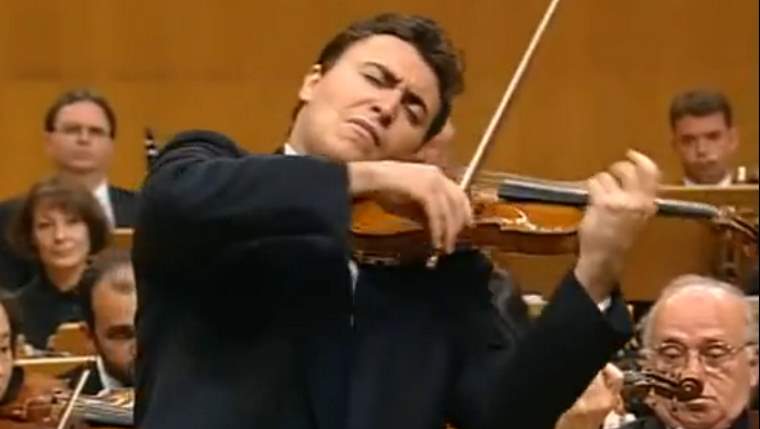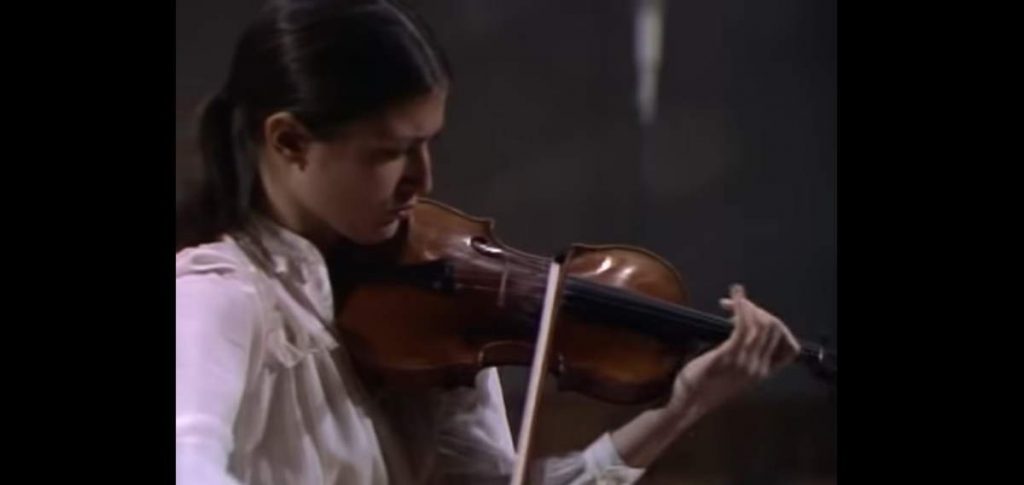Accompanied by the New Zealand Symphony Orchestra (NZSO), American classical violinist Hilary Hahn performs Jean Sibelius’ Violin Concerto in D minor, Op. 47. Conductor: Pietari Inkinen. This performance was recorded live in 2010 in Geneva, Switzerland.
Sibelius’ Violin Concerto
Four years before the death of the Hungarian violinist, conductor, composer, and teacher Joseph Joachim (1831-1907), who inspired a great number of 19th-century musical compositions, Jean Sibelius began writing his own Violin Concerto, composed between his second and third symphonies.
Sibelius originally dedicated the concerto to the noted violinist Willy Burmester, who promised to play the concerto in Berlin. For financial reasons, however, Sibelius decided to premiere it in Helsinki, and since Burmester was unavailable to travel to Finland, Sibelius engaged Victor Nováček (1873-1914), a Hungarian violin pedagogue of Czech origin who was then teaching at the Helsinki Institute of Music (now the Sibelius Academy).
However, contrary to Brahms for example, the concerto was not written with Joachim in mind, or even performed by the famous violinist. The concerto was first heard in 1903, then premiered in its final version on 19 October 1905 in Berlin, performed by Karl Halir and conducted by Richard Strauss.
The work bears witness to Sibelius’s desire to add a sense of vigor to his musical expression, a density far from the sentimentality, for example, of Glazounov (whose Violin Concerto also dates from 1903). Sibelius, himself a talented violinist, tackled one of the most traditional forms, respecting the tripartite progression (a rhapsodic first movement, a sublime cantilena, a joyful rondo), imbued with a unique and foreign inspiration.
Eight years later, Nielsen also attempted to renew the concerto form (divided into two parts, each with two movements), but his attempt did not have the same impact. At the heart of Sibelius’s creation, we find a musical universe both changing and maturing. In 1904, Sibelius moved to Järvenpää, his final home thirty kilometers north of Helsinki, as if in search of a new environment, one of solitude and exigency.
Sibelius never sought modernity at all costs. He was of his time, and not one imposed by the day of his birth. When asked, in 1914 which composer of his time was the greatest, he answered without hesitation: “Schoenberg. But I also enjoy my own music”.
Little concerned by the musical fashions and current trends, Sibelius was nonetheless a victim of those, though well-intentioned, who saw him as the composer of rising Finnish nationalism.
Sibelius’ Violin Concerto – Movements
- Allegro moderato (with many tempo changes throughout) in D minor, in 2/2 mostly, with some sections in 6/4 and 4/4 time. The first movement, marked Allegro moderato, opens with a cushion of pianissimo strings pulsating gently. The soloist then enters with a characteristic IV-V-I phrase, in D minor G-A-D. The violin announces the theme and is briefly echoed by the clarinet, then continues into developmental material. More low woodwind and timpani accompany the soloist in several runs. Almost cadenza-like arpeggios and double stops and more runs are accompanied by more woodwind restatements of the theme. The strings then enter brazenly for the first time, announcing a second theme. Developmental material leads to a cadenza which then opens into the recapitulation. The ‘Allegro molto vivace’ coda ends with restatements of past themes.
- Adagio di molto in B-flat major and in 4/4 time. The second movement (‘Adagio di molto’) is very lyrical. A short introduction by clarinets and oboes leads into a singing solo part (on the G string) over pizzicato strings. Dissonant accompaniments by the brass dominate the first part of the song-like movement. The middle section has the solo violin playing ascending broken octaves, with the flute as the main voice of the accompaniment, playing descending notes simultaneously.
- Allegro, ma non tanto in D major and in 3/4 time. It opens with four bars of rhythmic percussion, with the lower strings playing ‘eighth note ‒ sixteenth note ‒ sixteenth note’ figures. The violin boldly enters with the first theme on the G string. This first section offers a complete and brilliant display of violin gymnastics with up-bow staccato double-stops and a run with rapid string-crossing, then octaves, that leads into the first tutti. The second theme is taken up by the orchestra and is almost a waltz; the violin takes up the same theme in variations, with arpeggios and double-stops. Another short section concluding with a run of octaves makes a bridge into a recapitulation of the first theme. Clarinet and low brass introduce the final section. A passage of harmonics in the violin precedes a sardonic passage of chords and slurred double stops. A passage of broken octaves leads to an incredibly heroic few lines of double stops and soaring octaves. A brief orchestral tutti comes before the violin leads things to the finish with a D major scale-up, returning down in flatted super-tonic (then repeated). A flourish of ascending slur-separate sixteenth notes, punctuated by a resolute D from the violin and orchestra concludes the concerto.
New Zealand Symphony Orchestra
![Sibelius: Violin Concerto [Hilary Hahn]](https://cdn-0.andantemoderato.com/wp-content/uploads/2022/09/Sibelius-Violin-Concerto-Hilary-Hahn-2010-1024x565.jpg)
Founded in 1947, the New Zealand Symphony Orchestra (NZSO) is a symphony orchestra based in Wellington, New Zealand.
The orchestra’s affiliated conductors to date include:
- Anderson Tyrer (1947-1950)
- Michael Bowles (1950-1953)
- Warwick Braithwaite (1953-1954)
- James Robertson (1954-1957)
- John Hopkins (1957-1963)
- Juan Matteucci (1964-1968)
- Franz-Paul Decker (1991-1996, chief conductor)
- James Judd (1999-2007, music director)
- Pietari Inkinen (2008-2015, music director)
- Edo de Waart (2016-2019, music director)
- Hamish McKeich (2016-2019, associate conductor; 2020-present, principal conductor in residence)
- Gemma New (2022, principal conductor)
Sources
- Jean Sibelius on Wikipedia
- Violin Concerto (Sibelius) on Wikipedia
- New Zealand Symphony Orchestra’s official website



